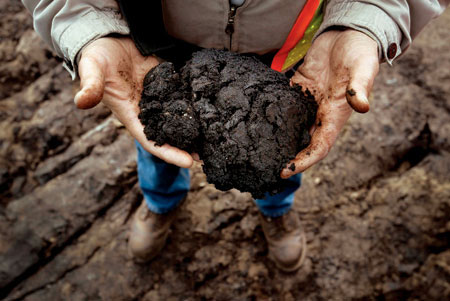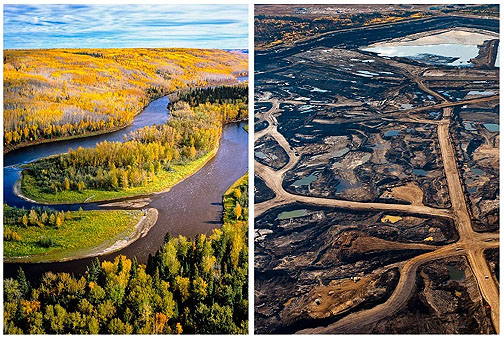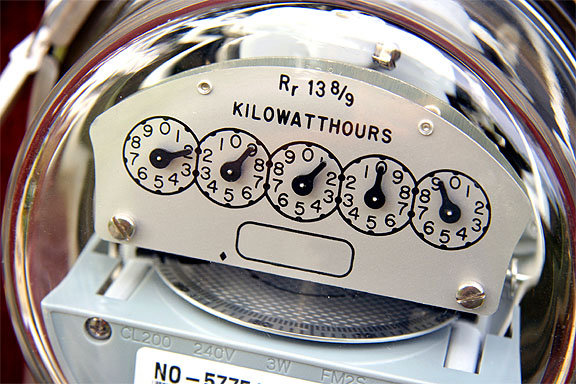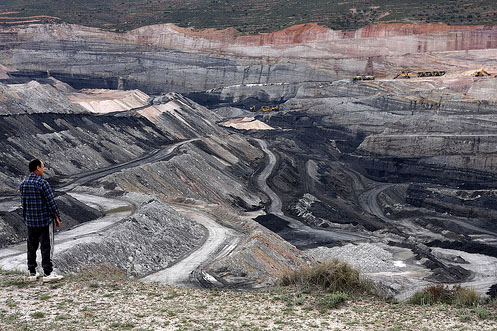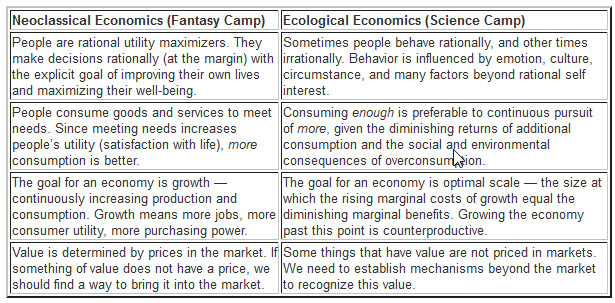I thought maybe I coined a new word recently: physophilia, meaning love of growth. It describes the — at times irrational – preoccupation with and addiction to economic growth that possesses politicians and many economists.
This misplaced attachment has already been the focus of several EcoOptimism posts, especially here and here. (While we’re not physophiles, I guess you’d have to say we have a love of the topic itself.) The essence of the problem is that economic growth, at least as it is usually defined, is not the great objective most of us think it is. It is neither advisable nor desirable. Yet it remains an assumed good.
In a post at one of my favorite blogs (you know you’re an eco geek when you regularly read posts from a site called the Center for the Advancement of a Steady State Economy), Brian Czech dives into this, noting that President Obama, as well as almost-President Gore, try to sell the idea that we can simultaneously address environmental issues and grow the economy. In his recent State of the Union address, the president said: “Now, the good news is, we can make meaningful progress on this issue [climate change] while driving strong economic growth.”
At first blush, this sounds like a strong and positive pronouncement, a “Yes, We Can” for environmentalism. But there’s that intractable little problem (as we’ve previously discussed – see the links at the top) of living on a finite planet, a place where infinite economic growth – especially one based on materialism – is a physical, mathematical impossibility. That’s the reason Czech calls the president’s declaration a “slippery slope” in which he “capitulate[s] to paltry cynicism” in not acknowledging the linkage between economic growth and pollution.
So growth is bad, right? That depends on what we mean by the word “growth.” And this isn’t a Bill Clinton “it depends on what the meaning of is is” hairsplitting moment. Economic growth is usually taken to mean an increase in the popular indicator, Gross Domestic Product. The problem, as so many have noted, is that GDP is a crappy measure of well-being. It’s entirely possible to have strong GDP “growth” while people are becoming worse off, which in fact is what’s happened in much of the developed world (and parts of the developing world as well) over the past few decades.
In short, economic growth – at least in its GDP definition – is neither sustainable nor desirable, even if we didn’t have environmental issues to deal with. Fortunately, economic growth is not really what we want. Economic growth is not the same as improved quality of life, and sometimes it’s the opposite, for instance if it means longer work hours or harsher conditions, or if it feeds off the “hedonic treadmill” in which we constantly have to work more to buy more.
Czech asks if we have to get the president off this slippery slope of promoting economic growth alongside environmentalism, and concludes that, no, “he’s too far into it.” That conclusion, though, makes the assumption that Obama can’t use his bully pulpit to educate and inform. Yeah, I know he hasn’t been great at that to date, but here’s my proposal: instead of sending the misleading and incorrect message that “there is no conflict between growing the economy and protecting the environment,” change the emphasis to address what we really want by saying “there is no conflict between improving the quality of our lives and protecting the environment.”
‘Growing the economy’ is an abstract goal that’s mostly irrelevant to living better lives. Many economists and environmentalists know this; the U.S. data have indicated as much since the middle of the last century. But the public, by and large, doesn’t realize this because of the fixation that politicians and the news media have on reporting GDP and other markers like the stock market. (A secondary proposal: can we please get the news media to stop putting GDP front and center?)
That word I thought I had coined – physophilia – well, it turns out that Juliet Schor and others were there first. There goes my shot at a wordsmith credit. Merely getting rid of physophilia, though a necessary prerequisite, will not solve everything. Much of our current economy is based on a presumption of growth; how else can investment be encouraged and debt be retired? There are, in fact, other economic models – truly sustainable ones, unlike what we have – such as the world described in Enough Is Enough. (See my review here.) But as I’ve mentioned (ad nauseum, or so it seems at times to me), it’s a communication issue. How do we eschew something as seemingly positive sounding as growth? It will take a convincing group of voices, with resounding sound bites, to change the goal from wins for the economy to wins for people. Czech sounds as if he’s given up on Obama taking the lead in this. “He’s uttered the win-win rhetoric one too many times; now he’d have to admit his mistake in addition to explaining the trade-off between economic growth and environmental protection.”
The EcoOptimist in me isn’t ready to do write Obama off just yet. In one sense, Czech is right: no politician wants to admit a mistake. But Obama doesn’t have to. He can instead redefine – in populist terms – what the goal really should be. It’s not the economy that we want to win; it’s us. It’s human growth, not economic growth.






